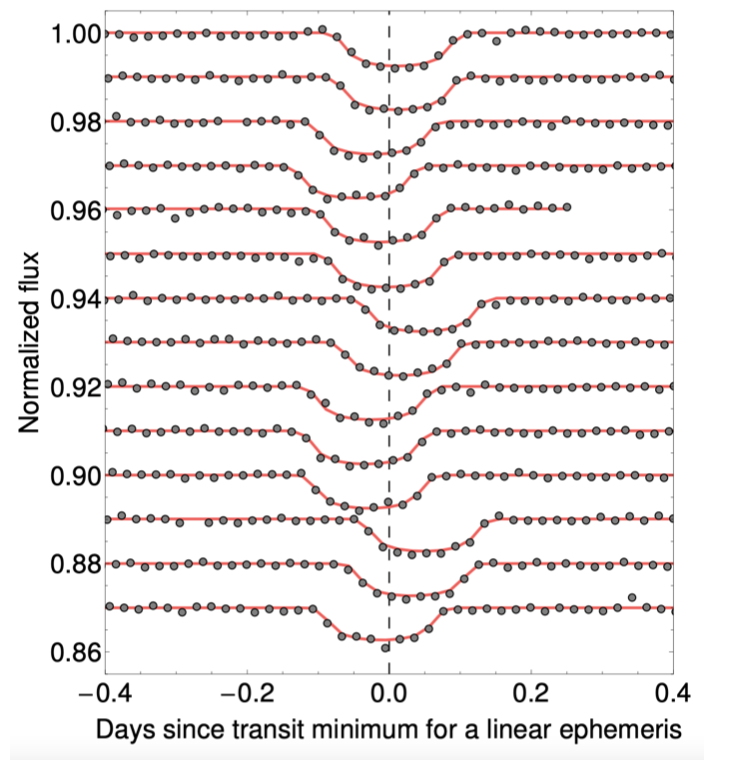Title: Evidence for Hidden Nearby Companions to Hot Jupiters
Authors: Dong-Hong Wu, Malena Rice, Songhu Wang
First Author’s Institution: Department of Physics, Anhui Normal University
Status: Submitted to AAS Journals [open access]
From the very beginning of the field of exoplanets, we have been in for surprises. The first exoplanet confirmed around a Sun-like star, 51 Pegasi b, for which Michel Mayor and Didier Queloz shared the 2019 Nobel Prize for Physics, was a huge surprise. It shocked astronomers because it is a planet about the same size as Jupiter in our Solar System, but it orbits its host star in only 4 days, compared to our Jupiter which orbits in 12 years. Our best theories on how gas giant planets like Jupiter form all require them to be in long orbits far from their host star, where it is cold enough for the gases to condense.
So how can a gas giant exist in such a close orbit to its star, where it is very hot? While astronomers have many new theories, we’re still not entirely sure. One clue that has helped theorists is the fact that, up until now, nearly all the Hot Jupiters we have discovered have been found to be the only planet in their system. What does this mean for the formation and evolution of these unique systems?
The theorists believe they can reconcile the fact that these gas giants should have formed far out from the star with the observational evidence that the planets are solo in their system. Many theories describe these planets as forming far out in the cold regions, then migrating inwards and in the process, these massive planets would gravitationally fling any other planets in the system out into the distant reaches of space, leaving a solo planet system.
These migration theories depend on these Hot Jupiters truly being lonely planets. But are they? A new paper revisits an important data set and dives deeper into this question.
The authors use the full Kepler data set for the first time to investigate the occurrence rate of companions in systems with a known single Hot Jupiter planet. The occurrence rate of companions represents how often a second planet occurs in a system. To find additional planets in these systems, the authors search for Transit-Timing Variations (TTVs).
A TTV is when we measure the transit of a planet to be occurring when we don’t expect it. For example, if we know of a planet that orbits its star every 5 days, then we would expect the transits of this planet to occur precisely every 5 days. We can even predict the transit time to within a minute in most cases. But sometimes the expected transit will occur a few minutes to hours earlier or later than expected. Figure 1 shows that the same planet can show varying TTVs across different transits. So what can cause planets to be early or late?

At their heart, TTVs are a gravitational effect. The reason a planet is early or late is because it is moving slower or faster than expected. The cause of the change in speed of the orbit is that the planet in question is experiencing a gravitational tug from another, non-transiting planet. The unseen planet pulls on the transiting planet just enough to slow it down or speed it up slightly, depending on the geometry of the system and the two orbits. Therefore, if we can measure the TTVs for a transiting planet, then we can infer the existence of a second, non-transiting planet in the system. And from the timescale of the TTVs we can make a measurement of the mass of the unseen planet.
The authors first identified each star in the Kepler data set that is known to have a single Hot Jupiter planet. They found 23 such systems, for which they searched the entire Kepler data set to look for TTVs. They found 16 systems that were experiencing TTVs, implying 16 new, non-transiting planets.
Finally the authors performed a statistical analysis. They factored in the number of systems with and without TTVs, Kepler’s sensitivity , the known biases in the method, and more. Ultimately they came to two conclusions. First, the companion occurrence rate is higher than previously reported. And second, the companion occurrence rate increases with the orbital period of the Hot Jupiter. In numbers, they found the companion occurrence rate for Hot Jupiters to be %, which is up from a previous studies that found
% and
% using only a subset of the Kepler data. Here they define a “Hot” Jupiter as having an orbital period between 1 and 10 days. Then for “Warm” Jupiters, a slightly different class of close in Jupiter sized planets defined as having longer orbital periods, from 10 to 300 days, they find the companion rate is
%, see Figure 2 for a histogram of their results showing companion occurrence rate as a function of the orbital period of the Hot Jupiter in the system.
This is a fascinating result! If Hot and Warm Jupiters have more companions than we previously thought, then this has big implications for the validity of our current best theories for how these planetary systems form and evolve. Just another surprise within the exciting field of exoplanet science!

Astrobite edited by Samantha Wong
Featured image credit: Nesvorny et al. 2012




